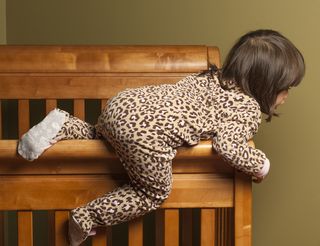Kids Who Climb in Home More Likely to Land in ER

Playing on the furniture like it's a jungle gym could end with a trip to the emergency room, according to a new study that finds that 3-year-olds with a propensity to climb are nearly 10 times more likely to end up seeing a doctor after a fall than kids of the same age who keep their feet on the floor.
The research also reveals that not putting up safety gates in the home, and failing to teach kids not to climb on furniture are linked to an increase in medical visits for falls.
Falls send more than 1 million U.S. children to the doctor or emergency room each year, according to the National Center for Injury Prevention and Control. Most of those falls are from couches, beds and other household furniture.
In the study, researchers in the United Kingdom gathered data on 672 young patients who fell down and got hurt, and who were treated at four National Health Service hospitals and clinics. Parents and caregivers answered questions about how the falls occurred, and about safety rules and features in the home, such as baby gates and the presence of high surfaces for climbing. [9 Weird Ways Kids Can Get Hurt]
The researchers compared the data with that of a control group of more than 2,600 kids who had not taken a tumble, but were matched in age, sex and neighborhood with those who had fallen.
Baby gates and boundaries
The findings revealed that for children, a climb is all too often followed by a fall. Three-year-olds whose parents reported that they climbed on furniture were 9.25 times more likely to fall from furniture than 3-year-olds whose parents said they didn't climb.
Sign up for the Live Science daily newsletter now
Get the world’s most fascinating discoveries delivered straight to your inbox.
The researchers also found that households without baby gates were about 1.7 times more likely to experience a fall than houses with gates deployed. And kids whose parents didn't teach them to keep off the furniture were 1.7 times more likely to fall from furniture than kids who were taught those rules.
Age made a difference, as well. Leaving a child under age 1 on a raised surface increased the risk of a fall by more than five times. Infants left in a car seat or a bouncy seat on a raised surface were twice as likely to fall as infants who were put only on the floor while in those devices.
Climbing kids
Most of the injuries in the study were minor, with 60 percent requiring no treatment. Fifty-nine percent of the kids in the study hit their head in the fall, 19 sustained minor cuts and scrapes, and 14 percent broke a bone. Only 4 percent required hospitalization.
The findings suggest that many falls are preventable, the researchers report today (Dec. 1) in the journal JAMA Pediatrics.
Doctors may be able to help by advising parents on fall prevention, they wrote.
Follow Stephanie Pappas on Twitter. Follow us @livescience, Facebook & Google+. Original article on Live Science.

Stephanie Pappas is a contributing writer for Live Science, covering topics ranging from geoscience to archaeology to the human brain and behavior. She was previously a senior writer for Live Science but is now a freelancer based in Denver, Colorado, and regularly contributes to Scientific American and The Monitor, the monthly magazine of the American Psychological Association. Stephanie received a bachelor's degree in psychology from the University of South Carolina and a graduate certificate in science communication from the University of California, Santa Cruz.
